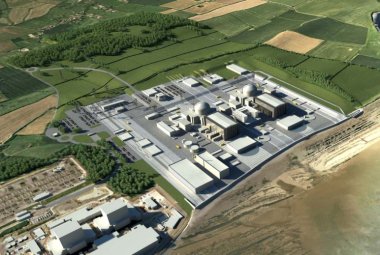British nuclear safety regulators have granted interim acceptance to the Areva EPR and Westinghouse AP1000. About one more year of licensing work remains, however, before new build can start.
The Generic Design Acceptance process was started in 2007 with a deadline for completion in the middle of this year dictated mainly by national energy security objectives. By about the middle of the process, however, it became clear that not all technical issues could be fully resolved in time and some would need to be left over for later resolution.
 |
| How Hinkley Point C could look. Site works are beginning under local planning permission, but construction of the nuclear plant itself is around a year away |
An announcement today by the Office for Nuclear Regulation (ONR) described two forms of interim acceptance: one from the ONR itself known as an Interim Design Acceptance Confirmation (IDAC) and another from the Environment Agency called an Interim Statement of Design Acceptability (ISODA). These cover a reactor's specification and operation, and environmental effects respectively. They establish that the reactors are fundamentally acceptable for use in the UK.
But before being given the final versions of these acceptances, Areva and Westinghouse must complete a batch of work addressing certain remaining issues and another explaining how they are taking on board the lessons of the Fukushima accident, as described by the report from chief regulator Mike Weightman.
Work plans have been agreed by both vendors to complete outstanding tasks to the satisfaction of the ONR, which stated firmly that "neither reactor can be built in the UK until these issues are resolved." The work is expected to take about a year for Areva, working in conjunction with its customer EDF. Officially, Westinghouse's work has been placed on hold until it has a utility customer in the UK.
Separate licensing processes also exist for operators, which require a nuclear site license from the ONR as well as permits from the Environment Agency. Approval from the Infrastructure Planning Commission will be required, as will a final consent from the ONR to begin installation of equipment related to nuclear safety.
Today's announcement was welcomed as a 'milestone' by industry, which noted the certainty given by the overall process and the agreed work plans. The regulators said the process identified potential issues "while plans are on the drawing board, before construction begins, and where solutions can be implemented more easily." Alan Raymant of Horizon Nuclear Power said the process gave "confidence" that the reactors "are suitable for the UK and that licensing approvals can be secured within a reliable time frame."
Having used nuclear power since the 1950s under a national program, the UK's fleet of reactors is being gradually depleted by retirements of the older units. Government policy is to facilitate their replacement by private industry and this has required a major overhaul of the framework for nuclear power, as part of a modernised energy policy that encourages investment in all kinds of low-carbon power.
Now there are a total of four new EPRs planned by EDF - two at Hinkley Point C and two at Sizewell C. Heavy forgings for the first at Hinkley were ordered from Areva in July. On a later schedule is Horizon Nuclear Power, which aims to develop a new plant alongside Wylfa in north Wales and should soon choose a reactor design. Later still is NuGeneration, developing proposals for a new nuclear power plant at the Moorside site near Sellafield in Cumbria. Between these three, some 19,000 MWe is being considered all to come online by 2023 - enough to re-establish nuclear power as the supplier of about 30% of UK electricity.
Researched and written
by World Nuclear News




_18570.jpg)
_16159.jpg)
_49205.jpg)
_18938.jpg)





